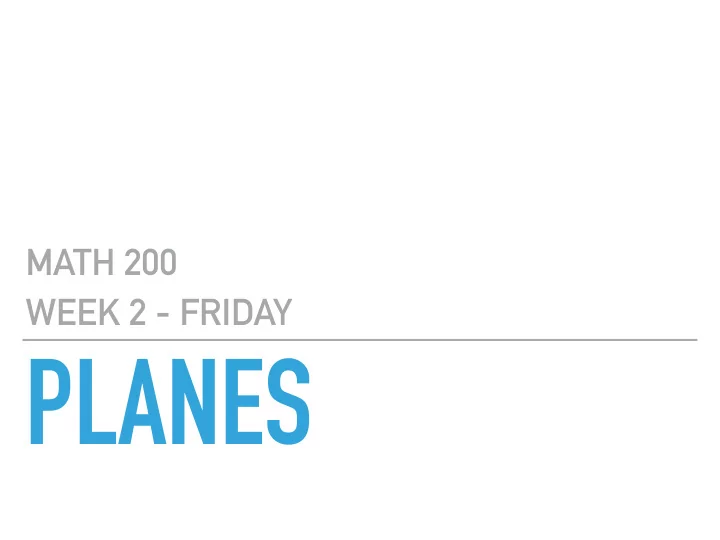

MATH 200 WEEK 2 - FRIDAY PLANES
MATH 200 MAIN QUESTIONS FOR TODAY ▸ How do we describe planes in space? ▸ Can we find the equation of a plane that satisfies certain conditions? ▸ How do we find parametric equations for the line of intersection of two (non-parallel) planes? ▸ How do we find the (acute) angle of intersection between two planes.
MATH 200 DEFINING A PLANE ▸ A line is uniquely defined by two points ▸ A plane is uniquely defined by three non-collinear points ▸ Why “non-collinear”? ▸ Suppose we have three points, A, B, and C in space… B A C
n MATH 200 B A C ▸ We can draw vectors between these points. ▸ We can find the vector orthogonal to both of these vectors using the cross product. ▸ This is called a normal vector ( n = <a,b,c> ) ▸ How does this help us describe the set of points that make up the plane?
n MATH 200 B P A C ▸ Consider a random point P( x,y,z ) on the plane. ▸ If A has components ( x 1 ,y 1 ,z 1 ), we can connect A to P with the vector AP = < x - x 1 , y - y 1 , z - z 1 > ▸ The vectors AP and n must be orthogonal! ▸ n • AP = 0 ▸ <a, b, c> • <x - x 1 , y - y 1 , z - z 1 > = 0
MATH 200 FORMULA ▸ So, given a point ( x 1 , y 1 , z 1 ) on a plane and a vector normal to the plane <a, b, c>, every point ( x, y, z) on the plane must satisfy the equation � x � x 1 , y � y 1 , z � z 1 � · � a, b, c � = 0 ▸ We can also multiply this out: a ( x − x 1 ) + b ( y − y 1 ) + c ( z − z 1 ) = 0 THIS IS CALLED POINT-NORMAL FORM FOR A PLANE
MATH 200 FIND AN EQUATION FOR A PLANE ▸ Let’s find an equation for the plane that contains the n following three points: B ▸ A(1, 2, 1); B(3, -1, 2); C(-1, 0, 4) A C ▸ We need the normal: n ▸ n = AB x AC ▸ AB = <2, -3, 1> and AC = <-2, -2, 3> ▸ n = AB x AC = <-7, -8, -10> ▸ Point-normal using A: -7(x-1) - 8(y-2) - 10(z-1) = 0
MATH 200 COMPARING ANSWERS ▸ Notice that we had three easy choices for an equation for the plane in the last example: ▸ Point-normal using A: -7(x-1) - 8(y-2) - 10(z-1) = 0 ▸ Point-normal using B: -7(x-3) - 8(y+1) - 10(z-2) = 0 ▸ Point-normal using C: -7(x+1) - 8y - 10(z-4) = 0 ▸ We also could have scaled the normal vector we used: ▸ -14(x-1) - 16(y-2) - 20(z-1) = 0 ▸ This makes comparing our answers trickier ▸ To make comparing answers easier, we can put the equations into standard form
MATH 200 ▸ Standard form : ▸ ax + by + cz = d ▸ Multiply out point-normal form and combine constant terms on the left-hand side ▸ E.g. ▸ Point-normal using A: -7(x-1) - 8(y-2) - 10(z-1) = 0 ▸ -7x + 7 - 8y + 16 - 10z + 10 = 0 ▸ -7x - 8y - 10z = -33 or 7x + 8y + 10z = 33 ▸ Point-normal using C: -7(x+1) - 8y - 10(z-4) = 0 ▸ -7x - 7 - 8y - 10z + 40 = 0 ▸ -7x - 8y - 10z = -33 or 7x + 8y + 10z = 33
MATH 200 EXAMPLE 1 ▸ Find an equation for the plane in standard form which contains the point A(-3,2,5) and is perpendicular to the line L (t)=<1,4,2>+t<3,-1,2> ▸ Since the plane is perpendicular to the line L, its direction vector is normal to the plane. ▸ n = <3,-1,2> ▸ Plane: 3(x+3) - (y-2) + 2(z-5) = 0 ▸ 3x + 9 - y + 2 + 2z - 10 = 0 ▸ 3x - y + 2z = -1
MATH 200 EXAMPLE 2 ▸ Find an equation for the n = <?,?,?> plane containing the point A(1,4,2) and the line L (t)=<3,1,4>+t<1,-1,2> ▸ We need two things: a <1,-1,2> A point and a normal vector (3,1,4) L ▸ Point: we can use A WE’LL PUT ALL THE INFORMATION WE HAVE DOWN ▸ Normal vector: ??? WITHOUT ANY ATTENTION TO SCALE OR PROPORTION ▸ Draw a diagram to help
MATH 200 n ▸ To get a normal we could take the cross product of two vectors on the plane. ▸ We have one: <1,-1,2> <1,-1,2> A(1,4,2) ▸ Form a second by connecting two points (3,1,4) L ▸ <-2,3,-2> � ˆ � ˆ ˆ i j k � � � � n = � 1 , � 1 , 2 � � �� 2 , 3 , � 2 � = � � 1 1 2 � � � � � 2 � 2 3 � � = � 2 � 6 , � 4 + 2 , 3 � 2 � = �� 4 , � 2 , 1 �
MATH 200 n = <-4,-2,1> <1,-1,2> A(1,4,2) (3,1,4) L ▸ Answer: ▸ Point-normal (using A): -4(x-1) - 2(y-4) + (z-2) = 0 ▸ Standard: -4x - 2y + z = -10
MATH 200 EXAMPLE 3 ▸ Find the line of intersection of the planes P 1 :x-y+z=4 and P 2 :2x+4x=10 ▸ Start with a diagram: ▸ P 1 has normal n 1 =<1,-1,1> ▸ P 2 has normal n 2 =<2,0,4>
Recommend
More recommend